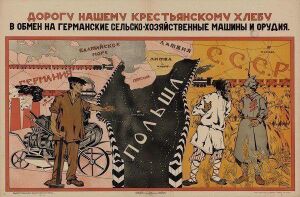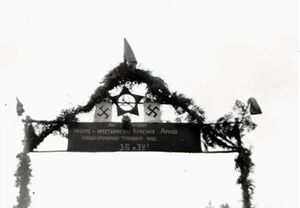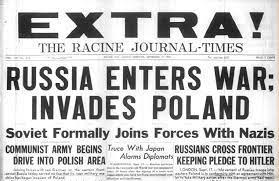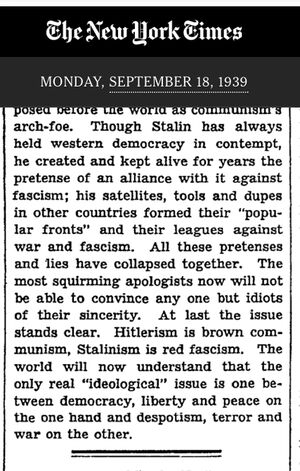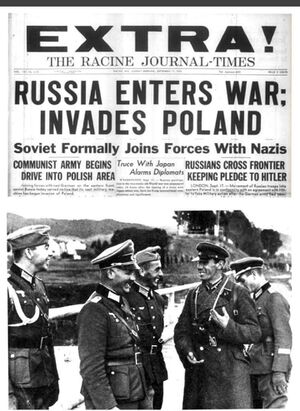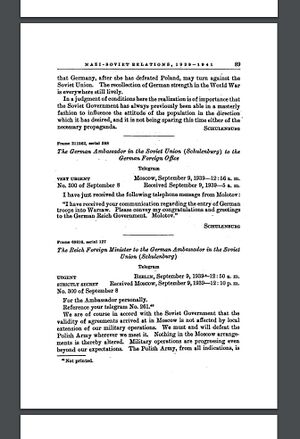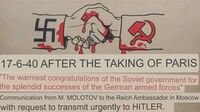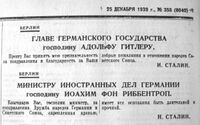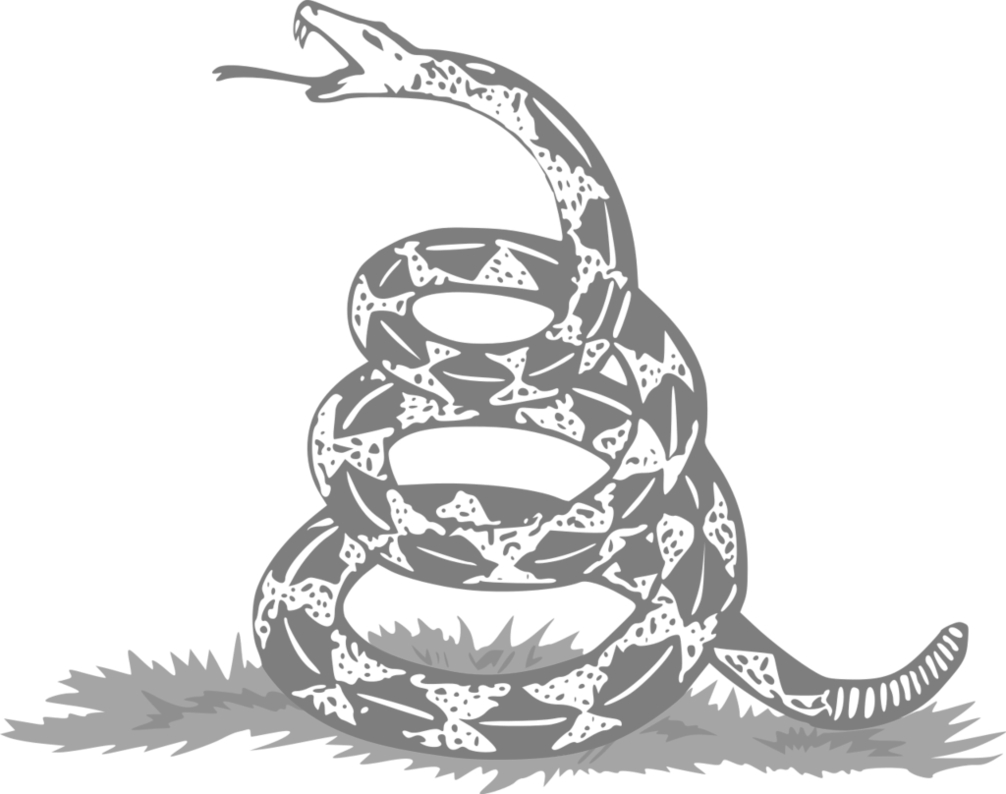Kremlinism/WWII: Difference between revisions
Timstarr2001 (talk | contribs) |
|||
| Line 93: | Line 93: | ||
"At a dinner toast with Allied leaders during the Tehran Conference in December 1943, Stalin added: 'The United States … is a country of machines. Without the use of those machines through Lend-Lease, we would lose this war.'" - https://it.usembassy.gov/america-sent-gear-to-the-ussr-to-help-win-world-war-ii/#:~:text=At%20a%20dinner%20toast%20with,1964%2C%20agreed%20with%20Stalin%27s%20assessment. | "At a dinner toast with Allied leaders during the Tehran Conference in December 1943, Stalin added: 'The United States … is a country of machines. Without the use of those machines through Lend-Lease, we would lose this war.'" - https://it.usembassy.gov/america-sent-gear-to-the-ussr-to-help-win-world-war-ii/#:~:text=At%20a%20dinner%20toast%20with,1964%2C%20agreed%20with%20Stalin%27s%20assessment. | ||
From "Russia's War," by Richard Overy: | |||
"The most serious gap in the Soviet armoury at the start of the war was in radio communication and intelligence. In the early months of the war there were desperate shortages of radio equipment, which made effective command and control of large numbers of aircraft and tanks impossible and made it difficult to hold together a regular infantry division. And when radio was used German interceptors caught the messages and dispatched air or tank strikes against the unfortunate command post that had relayed them. Soviet commanders soon grew uncomfortable with using radio once they realized it could betray their whereabouts. The system was disrupted in the fast-moving defensive battles of 1941 and 1942, as one communications post after another was overrun by the enemy. The effort to provide effective communication in 1942 was central to the final success of Soviet mass operations in 1943 and 1944. | |||
"It could not have been achieved without supplies from the United States and the British Commonwealth. Under the Lend-Lease agreements drawn up with America and Britain in 1941, the Soviet Union was supplied with 35,000 radio stations, 380,000 field telephones and 956,000 miles of telephone cable. The air force was able by 1943 to establish a network of radio control stations about one and a half miles behind the front, from which aircraft could be quickly directed to targets on the battlefield. Tank armies used the new radios to hold the tank units together, increasing their fighting effectiveness by the simplest of innovations." p. 193-194 | |||
"When the first aid programme was finally settled in October 1941, Maxim Litvinov, by then the ambassador to Washington, leaped to his feet and shouted out, 'Now we shall win the war!' Yet after 1945 Lend-Lease was treated in the official Soviet histories of the war as a minor factor in the revival of Soviet fortunes. The story of Lend-Lease became a victim of the Cold War. Even in the late 1980s it was still a subject of which the regime would not permit open discussion. The significance of Western supplies for the Soviet war effort was admitted by Khruschev in the taped interviews used for his memoirs, but the following passage was only published in the 1990s: 'Several times I heard Stalin acknowledge [Lend-Lease] within the small circle of people around him. He said that . . . if we had had to deal with Germany one-to-one we could not have been able to cope because we lost so much of our industry.' Marshal Zhukov, in a bugged conversation in 1963 whose contents were released only thirty years later, endorsed the view that without aid the Soviet Union 'could not have continued the war.' All this was a far cry from the official history of the Great Patriotic War, which concluded that Lend-Lease was 'in no way meaningful' and had 'no decisive influence' on the outcome of the war. | |||
"It is true that the quantity of armaments sent was not great when compared with the remarkable revival of Soviet mass production. The raw statistics show that Western aid supplied only 4 per cent of Soviet munitions over the whole war period, but the aid that mattered did not come in the form of weapons. In addition to radio equipment the United States supplied more than half a million vehicles: 77,900 jeeps, 151,000 light trucks and over 200,000 Studebaker army trucks. One-third of all Soviet vehicles came from abroad and were generally of higher quality and durability, though most came in 1943 and 1944. At the time of Stalingrad only 5 per cent of the Soviet military vehicle park came from imported stocks. Imports, however, gave the Red Army supply system a vital mobility that was by 1944 better than the enemy's. The Studebaker became a favourite with the Soviet forces. The letters 'USA' stenciled on the side were translated as 'Ubit sukina syna Adolfa'--'to kill that son-of-a-bitch Adolf!' The list of other supplies, equally vital to the Soviet supply effort, is impressive--57.8 per cent of aviation fuel requirements, 53 per cent of all explosives, almost half the wartime supply of copper, aluminium and rubber tyres. Arguably the most decisive contribution was supplies for the strained Soviet rail network, much of which was in the occupied areas in 1941. From America came not only 56.6 per cent of all the rails used during the war but 1,900 locomotives to supplement the meagre Soviet output of just 92, and 11,075 railway cars to add to the 1,087 produced domestically. Almost half the supplies, by weight, came in the form of food, enough to provide an estimated half-pound of concentrated nourishment for every Soviet soldier, every day of the war. The shiny tins of spam, stiff, pink compressed meat, were universally known as 'second fronts.' | |||
"The provision of Lend-Lease supplies was slow in the early stages of the war, but from late 1942 it became a steady flow through the Soviet eastern provinces via Vladivostok, by the overland route from the Persian Gulf and the more dangerous and inhospitable convoy journeys from British ports to Murmansk or Archangel. Foreign aid on such a scale permitted the Soviet Union to concentrate its own production on the supply of battlefront equipment rather than on machinery, materials or consumer goods. Without Western aid, the narrower post-invasion economy could not have produced the remarkable output of tanks, guns and aircraft, which exceeded anything the wealthier German economy achieved throughout the war. Without the railway equipment, vehicles and fuel the Soviet war effort would almost certainly have foundered on poor mobility and an anaemic transport system. Without the technical and scientific aid - during the war 15,000 Soviet officials and engineers visited American factories and military installations - technological progress in the Soviet Union would have come much more slowly." - pp. 195-198 | |||
== Stalin offer to the West ? == | == Stalin offer to the West ? == | ||
Revision as of 13:25, 7 June 2024
"I have received your communication regarding the entry of German troops into Warsaw. Please convey my congratulations and greetings to the German Reich Government. Molotov."
https://avalon.law.yale.edu/20th_century/ns065.asp
http://edition.cnn.com/2011/WORLD/europe/06/24/holocaust.rape/index.html
https://individual.utoronto.ca/jarekg/Ravensbruck/LastDays.html
https://neweasterneurope.eu/2022/04/21/the-crimes-of-bucha-have-a-long-history/
Mass rapes
https://twitter.com/catatonius/status/1656036094947803145
https://twitter.com/fellaraktar/status/1656025977418285056
What did ruSSian victory in 1945 look like for those in the ruSSian zone of occupation?
Well here is an example.
During the final period of the war and the period of occupation that followed, Soviet soldiers committed mass sexual assault on a horrifying scale.
It is estimated that 2 million German women, between the ages of 8-80, were raped by Soviet forces. An estimated 240'000 German women died as a result of these sexual assaults. Some of these women were raped 60-70 times by many different soldiers.
100'000 of these rapes happened in Berlin, leading to 10'000 deaths.
This didn't just happen in Germany.
The first reports of mass rape by Soviet soldiers came during battles for Romania and Poland. There are also large numbers of reports of Soviet soldiers raping Soviet women. But the actions of Soviet soldiers in Germany are perhaps among the most well documented of their crimes.
When confronted about the actions of his men, Joseph Stalin said "We lecture our soldiers too much; let them have their initiative."
This is what Soviet victory looked like.
Rape. Murder. Brutality.
Now ask yourself. How much has really changed in the last 78 years?
https://norwegianscitechnews.com/2019/01/when-rape-becomes-a-weapon-in-war/
Soviet defeat without the West
Soviets would've lost in 1942 without America, as Stalin said: [1]
"At a dinner toast with Allied leaders during the Tehran Conference in December 1943, Stalin added: 'The United States … is a country of machines. Without the use of those machines through Lend-Lease, we would lose this war.'" - https://it.usembassy.gov/america-sent-gear-to-the-ussr-to-help-win-world-war-ii/#:~:text=At%20a%20dinner%20toast%20with,1964%2C%20agreed%20with%20Stalin%27s%20assessment.
From "Russia's War," by Richard Overy:
"The most serious gap in the Soviet armoury at the start of the war was in radio communication and intelligence. In the early months of the war there were desperate shortages of radio equipment, which made effective command and control of large numbers of aircraft and tanks impossible and made it difficult to hold together a regular infantry division. And when radio was used German interceptors caught the messages and dispatched air or tank strikes against the unfortunate command post that had relayed them. Soviet commanders soon grew uncomfortable with using radio once they realized it could betray their whereabouts. The system was disrupted in the fast-moving defensive battles of 1941 and 1942, as one communications post after another was overrun by the enemy. The effort to provide effective communication in 1942 was central to the final success of Soviet mass operations in 1943 and 1944.
"It could not have been achieved without supplies from the United States and the British Commonwealth. Under the Lend-Lease agreements drawn up with America and Britain in 1941, the Soviet Union was supplied with 35,000 radio stations, 380,000 field telephones and 956,000 miles of telephone cable. The air force was able by 1943 to establish a network of radio control stations about one and a half miles behind the front, from which aircraft could be quickly directed to targets on the battlefield. Tank armies used the new radios to hold the tank units together, increasing their fighting effectiveness by the simplest of innovations." p. 193-194
"When the first aid programme was finally settled in October 1941, Maxim Litvinov, by then the ambassador to Washington, leaped to his feet and shouted out, 'Now we shall win the war!' Yet after 1945 Lend-Lease was treated in the official Soviet histories of the war as a minor factor in the revival of Soviet fortunes. The story of Lend-Lease became a victim of the Cold War. Even in the late 1980s it was still a subject of which the regime would not permit open discussion. The significance of Western supplies for the Soviet war effort was admitted by Khruschev in the taped interviews used for his memoirs, but the following passage was only published in the 1990s: 'Several times I heard Stalin acknowledge [Lend-Lease] within the small circle of people around him. He said that . . . if we had had to deal with Germany one-to-one we could not have been able to cope because we lost so much of our industry.' Marshal Zhukov, in a bugged conversation in 1963 whose contents were released only thirty years later, endorsed the view that without aid the Soviet Union 'could not have continued the war.' All this was a far cry from the official history of the Great Patriotic War, which concluded that Lend-Lease was 'in no way meaningful' and had 'no decisive influence' on the outcome of the war.
"It is true that the quantity of armaments sent was not great when compared with the remarkable revival of Soviet mass production. The raw statistics show that Western aid supplied only 4 per cent of Soviet munitions over the whole war period, but the aid that mattered did not come in the form of weapons. In addition to radio equipment the United States supplied more than half a million vehicles: 77,900 jeeps, 151,000 light trucks and over 200,000 Studebaker army trucks. One-third of all Soviet vehicles came from abroad and were generally of higher quality and durability, though most came in 1943 and 1944. At the time of Stalingrad only 5 per cent of the Soviet military vehicle park came from imported stocks. Imports, however, gave the Red Army supply system a vital mobility that was by 1944 better than the enemy's. The Studebaker became a favourite with the Soviet forces. The letters 'USA' stenciled on the side were translated as 'Ubit sukina syna Adolfa'--'to kill that son-of-a-bitch Adolf!' The list of other supplies, equally vital to the Soviet supply effort, is impressive--57.8 per cent of aviation fuel requirements, 53 per cent of all explosives, almost half the wartime supply of copper, aluminium and rubber tyres. Arguably the most decisive contribution was supplies for the strained Soviet rail network, much of which was in the occupied areas in 1941. From America came not only 56.6 per cent of all the rails used during the war but 1,900 locomotives to supplement the meagre Soviet output of just 92, and 11,075 railway cars to add to the 1,087 produced domestically. Almost half the supplies, by weight, came in the form of food, enough to provide an estimated half-pound of concentrated nourishment for every Soviet soldier, every day of the war. The shiny tins of spam, stiff, pink compressed meat, were universally known as 'second fronts.'
"The provision of Lend-Lease supplies was slow in the early stages of the war, but from late 1942 it became a steady flow through the Soviet eastern provinces via Vladivostok, by the overland route from the Persian Gulf and the more dangerous and inhospitable convoy journeys from British ports to Murmansk or Archangel. Foreign aid on such a scale permitted the Soviet Union to concentrate its own production on the supply of battlefront equipment rather than on machinery, materials or consumer goods. Without Western aid, the narrower post-invasion economy could not have produced the remarkable output of tanks, guns and aircraft, which exceeded anything the wealthier German economy achieved throughout the war. Without the railway equipment, vehicles and fuel the Soviet war effort would almost certainly have foundered on poor mobility and an anaemic transport system. Without the technical and scientific aid - during the war 15,000 Soviet officials and engineers visited American factories and military installations - technological progress in the Soviet Union would have come much more slowly." - pp. 195-198

